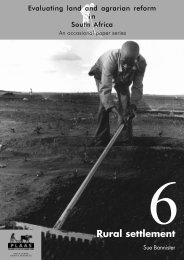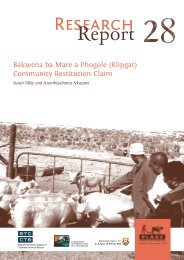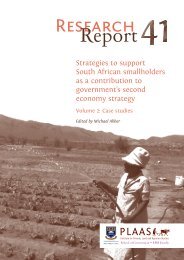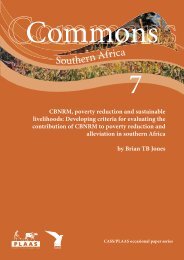Download Ch10 - PLAAS
Download Ch10 - PLAAS
Download Ch10 - PLAAS
- No tags were found...
Create successful ePaper yourself
Turn your PDF publications into a flip-book with our unique Google optimized e-Paper software.
New institutionalmechanisms? 10235Attention must now be paid to the neglected question of what kind of farming systems should bethe outcome of land reform. No district-level planning, as is now being rolled out through areabasedplanning, is possible without including a clarification of this issue, or it will lead merely to thereplication of a version of the existing agrarian structure. In particular, it is not possible to specifywhat kind of pre- and post-transfer support is required, and thus what agencies need to be in positionwith what resources, unless there is a clear resolution of this issue.The failure to clearly specify an alternative farming system is indicative of an enduring hostility tosmallholder farming as a possible end-product of land reform, as several commentators have noted,including those as different in their outlook as Ben Cousins of <strong>PLAAS</strong> and Rogier van den Brink of theWorld Bank. This alternative perspective has pointed to the advantages of smallholder production:• it can be commercial (i.e. it is not synonymous with ‘subsistence’) and it can be a mix ofproduction for own consumption and for markets;• it can be more intensive and provide more livelihoods in a given area;• it can lead to inverse returns to scale;• it can be located on subdivided holdings to make use of underutilised land; and• it is available to a wider range of beneficiaries, including the poor.This chapter strongly concurs that an alternative policy framework for land and agrarian reformin South Africa must include smallholder farming as a major element, but the kind of smallholderproduction, and the other options that should be promoted (e.g. workers’ co-operatives on existingfarm units) should be worked out in terms of what is appropriate to objectively defined social needsand agro-ecological parameters. Specific proposals then need to be worked out at the provincial anddistrict levels. This much is acknowledged in some of the current discourse.Alternative strategies should not necessarily seek the short-run optimisation of total production andyield per hectare, but rather should aim to provide increased numbers of livelihoods from the landpresently in the commercial farm sector (including that which is not fully utilised). The large farmsector has lost workers on a huge scale in the last 20 or so years. By 2002, total employmentin agriculture had dropped about 30% from some 1 320 000 in 1985 to 940 000. The loss oflivelihoods is illustrated more dramatically by taking into account that the number of those in full-timeemployment has almost halved, as a result of labour being made more casual. There is an implicitassumption that such losses are a result of ‘efficiency gains’, but they may be a consequence of landbeing left idle or changes in types of production. No systematic research has been done to clarify thereasons for this trend, and thus no strategies are on offer to counter it. The large commercial farmsector has been leaking a generation of people and livelihoods – the exact opposite of what economicdevelopment and anti-poverty programmes require. The challenge is to design a land reform strategythat can reverse that trend and aim to have not just more people dwelling on the land but morepeople gainfully occupied, deriving part if not the whole of their livelihoods from the land.Alternativestrategies shouldnot necessarilyseek the shortrunoptimisationof totalproduction andyield per hectareNew institutional requirementsAlternatives to the past programmes of land redistribution will require agencies to perform new oramended roles. The resolutions of the 2005 Land Summit mark a departure from earlier policies in
238 Another countryside?indeed one of the more serious problems from this point of view of the organization andefficacy of action is the coordination of the activities of the various organs of government…For the success of an agrarian reform process it is necessary to act simultaneouslyand complementarily in various fields: land has to be redistributed among the peasantbeneficiaries; they have to be organized and given credit in order to carry out variousinvestments and to operate the new enterprises that are created; they have to receive thetimely supply of various productive factors; they have to receive technical training andeducation; their crops have to be bought at prices that will compensate them for their efforts;markets and cooperatives have to be organized; the produce has to be bought and distributedto urban centres, etc. All these functions are complementary and if one of them does notwork well or fails, a large part of what is being done in the other areas will be frustrated.(Chonchol 1964)In Colombia, an agency, INCORA (Instituto Colombiano de Reforma Agraria) was set up in 1961,with responsibilities for the acquisition of land through voluntary purchases from willing sellers,and compulsory purchases of land that met the legislation’s criteria for purchase (above ceiling sizeor underutilisation), the distribution of such land and of state lands earmarked for redistribution,development of infrastructure in support, provision of agricultural credit to beneficiaries, and thedirect running of irrigation and drainage projects. Under a more progressive government from 1966,INCORA greatly expanded its budget for acquisitions and other purposes. It also promoted peasantassociations to mobilise for expanding land reform, which later led to some invasions, but also to theformation of a National Association of Peasant Beneficiaries that provided political support for landreform measures and also provided a part of the administrative structure through which the reformswere implemented. After 1971, under a conservative government, the pace of land reform and theextent of INCORA’s role were slashed, a moratorium was declared on its further acquisition of landand it was criticised by the right wing for its support of radical rural social movements.In Peru, the 1964 reforms were aimed at bringing the landed estates in the mountains (the Sierra)into modern farming, although, in fact, they had become partly commercialised. These reformsachieved little, except to spark land invasions by peasants. The radical military government enactedits own land reform in 1969, targeting instead the export-oriented commercial plantations in thecoastal area (De Janvry 1981). Commercial enterprises were expropriated and converted into cooperatives,comprised mainly of the previous workers on the plantations – one of the most extensivereforms in Latin America. One crucial task was the provision of state-appointed managementadvisers to liaise with the agricultural co-operatives (CAPs) and issue them with advice (often, infact, directives). Later governments partially reversed this process, as part of structural adjustment,and parcelled out the co-operatives’ land. One institutional innovation in Peru was the setting up ofindependent land tribunals, which had the final say in appeals about whether a landowner could, byvirtue of size or underutilisation of holdings, be subject to the rules for takeover. Thus, one dimensionof expropriation was not directly in the hands of a central agency. Financial institutions of governmentwere also involved, as the system of compensation was through deferred payments of bonds, which,in turn, were supposed to finance industrial growth.In Chile, the first land reform under Christian Democratic governments in the 1960s was intendedto pre-empt social unrest and to modernise agriculture. The Agrarian Reform Corporation (CORA)was empowered to purchase land from willing sellers – though the law allowed deferred paymentsin the form of 25-year bonds – and to expropriate underutilised land and land above certain ceilings(Bellisario 2007). An Agricultural Development Institute (INDAP) not only conducted research butpromoted peasants, trade unions and co-operatives to give a popular push to the process, andit was estimated that half the campesinos (peasants) were organised under such bodies. Under
New institutionalmechanisms? 10239Allende’s Popular Unity government, the head of INDAP, an agricultural engineer, became Ministerof Agriculture and implementation was given a much greater thrust (six times more land wasredistributed in the first year than in the previous six years). In addition, agricultural marketing, inputsupply and credit agencies were nationalised, though not placed under CORA, so there had to bemechanisms for co-ordination. In fact, there was close collaboration between CORA and the Ministryof Agriculture, both under dynamic, committed leadership. They, in turn, fed into Centres for AgrarianReform that organised tenants, former workers and nearby peasants on the ground, so as to benefitfrom the reforms.In Venezuela in the 1960s, a National Institute for Agriculture (IAN) was set up as an autonomousagency of the Ministry of Agriculture and Livestock to be the ‘responsible executing agency’ forland reform. Its responsibilities covered land acquisition, assessment of compensation to be paid,determination of sizes and holdings to be allocated, actual distribution of land, construction of basicinfrastructure, technical assistance and extension and administration of the Agriculture & LivestockBank.By the 1970s and 1980s, most Latin American countries had shifted to ‘integrated ruraldevelopment’ without land redistribution. In the process, these institutions were dismantled andmuch of the accumulated knowledge and experience was lost. Venezuela, Bolivia and Chile areexceptions, where some emphasis on land reform has re-emerged in the new millennium.these institutionswere dismantledand much ofthe accumulatedknowledge andexperience waslostAfrican experiencesExperiences comparable to South Africa are limited to the former ‘settler colonies’, where there wasextensive occupation of the land by white immigrants. This history also left a legacy (as in SouthAfrica) of a distinctly dualist structure of agriculture, with large-scale commercial farms, ranchesand plantations, on the one hand, and ‘reserves’ of peasant family holdings variously constrained bylimits on land, access to markets and support services, finance and legal prohibitions, on the other.This dualism was reflected in the bipolarisation of government structures. Departments of agricultureprovided high levels of servicing, often including the design of farm plans, supply of farming inputs,credit and state marketing exclusively for the white-owned land, while ‘native administrations’ wereconcerned with social control and land matters, with some added-on farming support services.Clearly, land reform designed to reverse the dualism also required some governmental restructuringof this inherited divide between service provision for large farms and mere administration of land andpeople in the ‘reserves’. Those countries that have undertaken significant redistribution of such landinclude Algeria, Mozambique and Angola, but the cases of the anglophone ex-colonies of Kenya andZimbabwe are most relevant.Kenya was the first anglophone ex-settler colony to launch a programme of transferring land fromwhite to African farmers. The Million Acre Scheme launched in 1961, just before independence,targeted one type of farming enterprise in the former ‘White Highlands’: the owner-manager individualholdings under mixed farming (mainly maize, wheat and cattle), particularly those bordering theAfrican ‘reserves’, but left untouched the tea, coffee, sisal and sugar plantations. It was initially led bya Land Settlement and Development Board, heavily influenced by the interests of the white farmingcommunity in determining which land should be transferred, but this was replaced by a Central LandBoard, which became the agency for purchasing the land. The Ministry of Lands, later amalgamatedwith the Ministry of Agriculture, was also responsible for post-transfer support of the smallholdings.
240 Another countryside?Picture of women on theirsmallholding, taken byanother farmer, in Maragoli,Kenya. (Verma, 2001)The land andagriculturaldepartments...were broughttogether underone ministryIn sum, there was a co-ordinated agency at the core of resettlement, but the relations between thisbody and ministries and departments were characterised by political confrontation, and in wrestingsome control from the white settlers, a degree of co-ordination over the acquisition and settlementprocesses, and between administration of land transfer and support to post-transfer farming, was lost.After the ten years that the Million Acre Scheme lasted, the state withdrew from land redistribution;indeed, there was no longer any co-ordinating body such as the Central Land Board and, thus, noinstitutional memory survived.In Zimbabwe, after independence in 1980, the new government set itself the aim of resettling165 000 peasant families on formerly white-owned farms. The land and agricultural departmentsthat had dealt with white farming areas and communal areas were brought together under oneministry; the two distinct extension and servicing departments were combined within the ministry toform AgriTex, which was responsible for agricultural infrastructure, extension and production support,and was a considerable store of technical know-how.However, the land acquisition unit in the separate Ministry of Lands operated autonomously fromAgriTex, and the new co-ordinating agency for resettlement, DERUDE (see below), bought up a stockof some 2.5 million hectares – about 30% of the white-owned farms – in the short period from 1980to 1982. Its decisions about which farms on offer to purchase (many of which had been abandonedduring the liberation war) were taken without any real consideration of suitability for resettlement,and this was the basis for criticism by the planners who later had to put the land to use. Many ofthe acquired farms bordered communal lands, often the site of fighting during the war, and by andlarge were the less fertile areas. Out of this inherited structure, mechanisms had to be put together to
New institutionalmechanisms? 10241design and implement a programme for resettlement, involving continuing acquisition of white-ownedfarms and the resettling of African farmers on the land.The planning branch of AgriTex in the separate Ministry of Agriculture designed the land-use formulaeand the physical layout to be used on the former commercial farms and, thus, the whole nature of the‘resettlement schemes’. Its considerable technical expertise and experience, however, was based onthe ‘land-use planning’ of single large-scale commercial enterprises, so it had to adjust its thinking tosmallholder alternatives without much experience. Alexander (2006) and Moore (2005) criticise thistechnicist approach and its bureaucratic implications. AgriTex proposed four models for the schemes,of which the most widespread by far, Model A, envisaged smallholder farming: individual householdswere allocated a homestead plot, arable fields plus shared access to a sizeable area to be used incommon for grazing livestock and collecting firewood and other natural products. There were alsomodels for co-operatives, for out-grower schemes around estates with processing facilities, and for theextension of communal area grazing land.individualhouseholdswere allocated ahomestead plot,arable fields plusshared accessto... grazingA third agency, specially created for the purpose rather than a ‘retread’ of old agencies, theDepartment of Rural Development (DERUDE), was then set up within a third ministry, that ofLocal Government, Rural and Urban Development, and charged with selecting households fromthose registering their need, placing them on the plots, administering the schemes, co-ordinatingthe construction of infrastructure, and seeing to the extension of access to credit. Many of the newfield staff recruited for these tasks were ex-liberation movement fighters, who saw themselves asmobilisers and on the ‘side of the people’, of a different ilk to the old guard of the settler-colonialbureaucracy. Although DERUDE came into existence too late to co-ordinate acquisition with theplanning of schemes, it did develop some co-ordinating expertise and also provided a pro-reformpolitical constituency within an otherwise conservative bureaucracy. Eventually, it did come close tobeing a ‘dedicated’ land reform agency.These three institutions were scaled back in the late 1980s, and DERUDE was finally disbanded inthe early 1990s as part of structural adjustment. In the process, much accumulated experience waslost. The absence of any co-ordinating agency has meant that the fast-track land reform since 2000has not only suffered from an absence of planning, but has also left new land users with limited, ifany, support for production. The sheer scale and speed of these recent transfers has also been suchthat the institutions intended to provide technical support, credit, inputs and administration (includingsettlement of the many disputes over the transferred land) have been overwhelmed.Implications for South AfricaThere is no single structure that is ideal in all situations. What is appropriate will depend on thepolitical context and the strategy for land reform. However, a number of criteria may be isolated:• From a public administration perspective, it is important to have a capable single agency or setof institutions that can plan and implement this demanding task.• Sheer capacity has to be on a scale sufficient for the extent of the operation, and a majorquantitative shift would be necessary for South Africa to reach its targets.• Choices have to be made about the extent to which new bodies are created or existing onesrestructured and redirected to undertake the required new tasks.
242 Another countryside?• Given the multidisciplinary nature of the tasks and the several stages of the process, coordinationis a high priority. One strategic decision is how to achieve this: a dedicated agency orcommittees that network and can command executive authority.• Both property and bureaucratic interests will be challenged in any land reform. The political taskis not to inflate the opposing interests but to assess and mobilise the political forces that arelikely to support the reforms.Several of the country experiences above offer examples of a dedicated agency attempting to coordinate,if not always being the sole implementer of, a range of activities. However, the problemsof co-ordinated planning and implementation are often contested and subject to conflict, perhapsinevitably. In reconstituting institutions appropriate for a second stage of land reform in South Africa,there are lessons, both positive and negative, that might be applied.countries werevictims ofinstitutionalarchitecturerooted in theirpast politics.South Africais similarlyconstrainedOne lesson is that countries were victims of institutional architecture rooted in their past politics.South Africa is similarly constrained by the inherited dichotomous responsibility along racial linesfor agriculture, land and local government, with the great preponderance of expertise and resourcesin those structures that ministered to white farming needs. A further problem in getting institutionsright is that the Constitution specifies Land Affairs as a national government competency, whereasoperational responsibility for agriculture lies with provincial governments. There are obvious benefitsto housing all relevant functions under one institutional roof, but this may sideline land reform inpractice, if such a body is starved of a strong political voice at the centre of government and of themeans to implement its plans, including an adequate budget of its own.The Department of Land Affairs, which has been central to land reform, at present does not havethe expertise for some tasks or the will to be an effective co-ordinator. Municipalities, chargedwith co-ordinating local economic development, may not be able to draw in national or provincialdepartments, especially of agriculture, which must have some crucial technical role. Responsibilityfor some required tasks (e.g. for the design of area-based plans, and for state purchase of land) is notclearly specified.A new multidisciplinary, dedicated land reform agency would perform a range of tasks. Butwhere would it be located and to whom should it be answerable? Would it be a specialist unitwithin municipalities, or an autonomous body with a degree of independence? How would civilsociety organisations and rural communities themselves have an input into planning and holdingthe implementers accountable? Participatory structures should ideally seek to co-ordinate nongovernmentbodies within plans, rather than have them as alternatives to the government institutions.Experiences elsewhere in the world suggest that civil society bodies are crucial in driving broadpopular mobilisation without which public bodies might be reluctant to move at all.The conclusion offered here is not to draw up a new organogram or blueprint, but to encourage policydebates to include a working group that can look at the range of organisational reforms that will beneeded to take a new agrarian reform strategy forward.
New institutionalmechanisms? 10243ReferencesAlexander, J. 2006. The unsettled land: State-making and the politics of land in Zimbabwe, 1893–2003. Oxford: J. Currey.Bellisario, A. 2007. The Chilean agrarian transformation: Agrarian reform and capitalist ‘partial’counter-agrarian reform, 1964–1980. Part 2: CORA, post-1980 outcomes and theemerging agrarian class structure. Journal of Agrarian Change 7(2): 145–182.Chonchol, J. 1964. Eight fundamental conditions of agrarian reform in Latin America, inStavenhagen, R. (ed.) Agrarian problems and peasant movements in Latin America.New York: Anchor Books.Cliffe, L. 2000. Land reform in South Africa. Review of African Political Economy 84: 273–286.De Janvry, A. 1981. The agrarian question and reformism in Latin America. Baltimore: JohnsHopkins University Press.Moore, D. 2005. Suffering for territory: Race, place and power in Zimbabwe. Harare: Weaver Press.Van den Brink, R., Thomas, G., Binswanger, H., Bruce, J. & Byamugisha, F. 2006. Consensus,confusion and controversy: selected land reform issues in sub-Saharan Africa.Washington DC: World Bank.Verma, R., 2001, Gender, Land and Livelihoods: Through Farmers’ Eyes, Ottawa: IDRC.
















